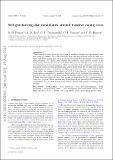Self-gravitating disc candidates around massive young stars
Abstract
There have been several recent detections of candidate Keplerian discs around massive young protostars. Given the relatively large disc-to-star mass ratios in these systems, and their young ages, it is worth investigating their propensity to becoming self-gravitating. To this end, we compute self-consistent, semi-analytic models of putative self-gravitating discs for five candidate disc systems. Our aim is not to fit exactly the observations, but to demonstrate that the expected dust continuum emission from marginally unstable self-gravitating discs can be quite weak, due to high optical depth at the mid-plane even at millimetre wavelengths. In the best cases, the models produce ‘observable’ disc masses within a factor of <1.5 of those observed, with mid-plane dust temperatures comparable to measured temperatures from molecular line emission. We find in two cases that a self-gravitating disc model compares well with observations. If these discs are self-gravitating, they satisfy the conditions for disc fragmentation in their outer regions. These systems may hence have as-yet-unresolved low-mass stellar companions, and are thus promising targets for future high angular resolution observations.
Citation
Forgan , D H , Ilee , J D , Cyganowski , C J , Brogan , C L & Hunter , T R 2016 , ' Self-gravitating disc candidates around massive young stars ' , Monthly Notices of the Royal Astronomical Society , vol. 463 , no. 1 , pp. 957-964 . https://doi.org/10.1093/mnras/stw1917
Publication
Monthly Notices of the Royal Astronomical Society
Status
Peer reviewed
ISSN
1365-2966Type
Journal article
Description
DHF gratefully acknowledges support from the ECOGAL project, grant agreement 291227, funded by the European Research Council under ERC-2011-ADG. JDI gratefully acknowledges support from the DISCSIM project, grant agreement 341137, funded by the European Research Council under ERC-2013-ADG. CJC acknowledges support from STFC grant ST/M001296/1.Collections
Items in the St Andrews Research Repository are protected by copyright, with all rights reserved, unless otherwise indicated.

